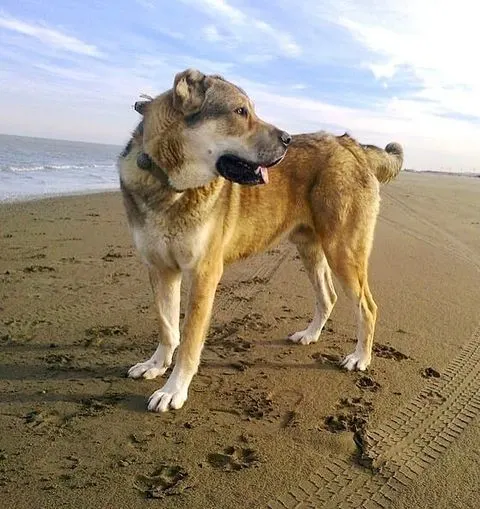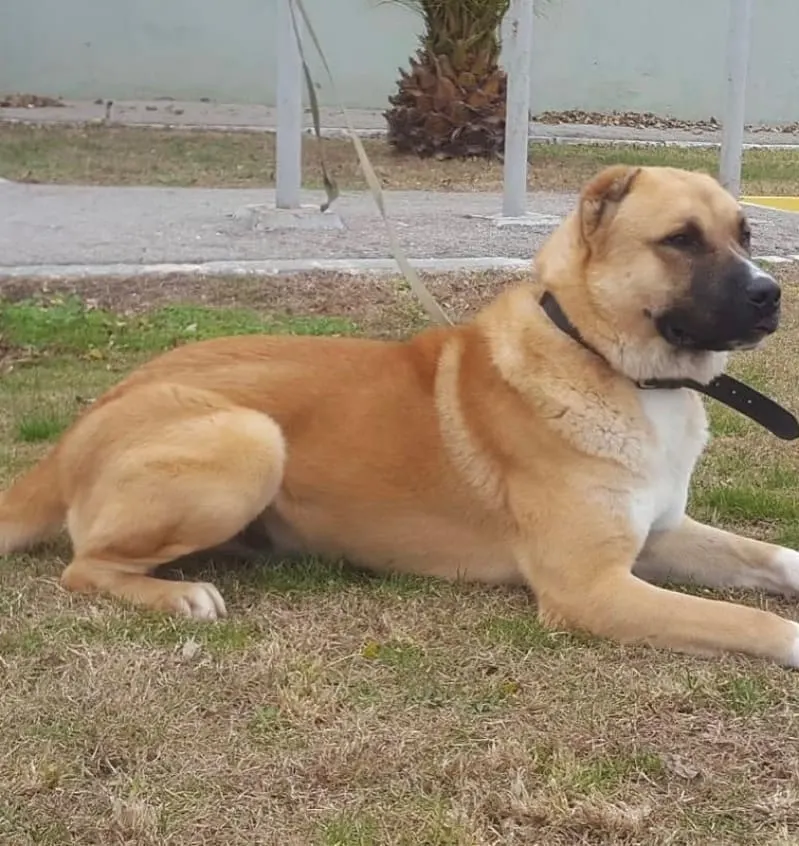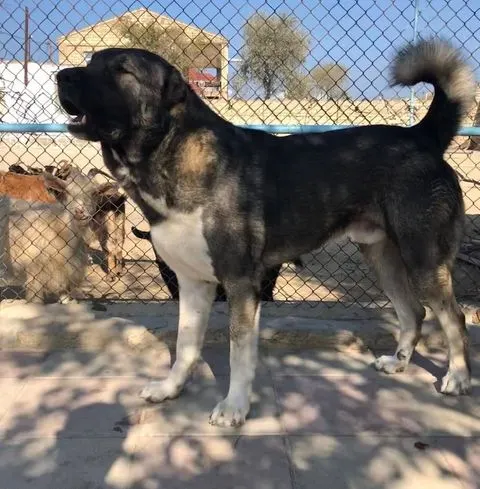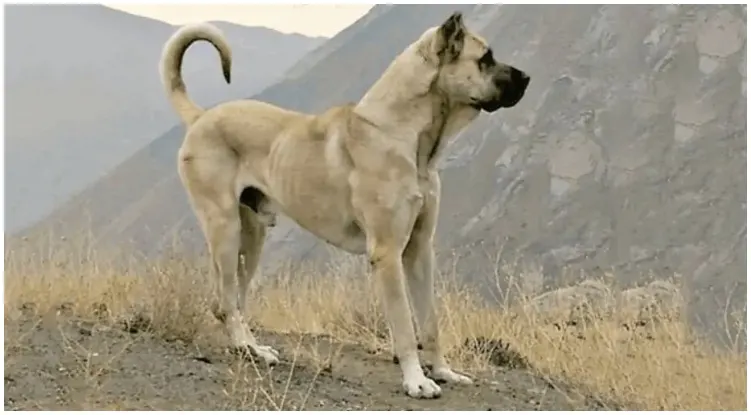Have you ever heard of the Sarabi dog?
No?
Maybe you’ve heard of the Azarbaijan Mastiff, Persian Mastiff, Iranian Shepherd, or Iranian Mastiff? All of these are the same dog breed!
This breed is a Molosser-type dog that was used as a guardian dog of livestock in Sarab County in northern Iran. Hence the name Sarabi dog!
They are probably the biggest dog that is said to hail from Iran. More specifically, East Azerbaijan, which is located in the northern parts of Iran.
The Sarabi dog is among the oldest dog breeds in Iran and holds a distinguished place in history, having served as a war dog during the time of the Persian Empire.
| Origin | Iran |
| Size | Large |
| Weight | 110-155 lbs (50-70 kg) |
| Height | 28-32 inches (71-81 cm) |
| Life Span | 12-15 years |
| Coat | Short to medium length, dense, and waterproof |
| Coat Colors | Brindle, black, brown, cream, red, white, or multi-color combinations |
| Temperament | Loyal, brave, intelligent, protective, strong |
| Purpose | Livestock guardian, protection, working dog |
| Exercise Needs | Moderate |
| Grooming Needs | Low to moderate |
| Socialization | Early and consistent socialization is essential |
| Training | Consistent, firm, and patient training is required |
| Living Environment | Rural or spacious areas with room to roam |
| Good with Children | Yes, when socialized and supervised |
| Good with Other Pets | Yes, with proper socialization and supervision |
Sarabi Dog – Breed of livestock guardian dog
To be more precise, they were used for centuries by local shepherds to protect herds of sheep and goats.
They would protect them from bears, wolves, jackals, and other local large predators.
The breed is believed to be one of Iran’s oldest and most powerful indigenous dog breeds.
Fun fact: The heavier and larger an individual dog is, the more valuable the dog is thought to be.
Before we get into all the details of the appearance of Sarabi Mastiff dogs, we want to tell you right away that this is a large dog.
This is a very big and bulky dog so they are not for everyone!
Even though they originated in Iran, this breed is especially popular in the USA, China, and Russia. Because of their history as watchdogs, they’re usually mostly used to guard property. But, because of their beautiful nature, they remain popular family pets. As a side note, they are not a wise choice for first-time owners.
Because there is so much to know about this dog, we decided to put together the complete guide to the Sarabi dog. In this article, we’ll take a closer look at all the traits and especially the appearance of Sarabi Mastiff dogs.

Photo: Instagram @dogbreedsfan
All about Mastiff dogs
Before we start talking more about the individual dog that got it because of the name of a city – Sarabi Mastiff, let´s talk about the Mastiff breeds.
When we hear Mastiff we all think of giant, massive dogs, and they are giants.
The Mastiff belongs to the group of larger dogs. The minimum height of males is 30 inches tall and they can weigh up to 200 pounds when fully mature.
Females start at roughly 27 inches tall and weigh around 150 pounds.
So, it’s obvious, the Mastiff is a large, robust, and muscular dog.
Mastiff hybrids, on the other hand, are the result of crossbreeding mastiff breeds with other dog breeds, leading to a wide array of offspring boasting distinct characteristics.
Since olden history, these dogs have acted as human protectors, and with that devoted disposition comes a personality that is loyal, good-natured, and ready to please. Because of their bravery and docility, mastiffs are ideal companions for children and families.
Mastiffs are kind to children.
But keep an eye on them when they are around little children, since their big size may lead someone to be accidentally trodden on.
Mastiffs are very clever and sensitive animals, which makes them excellent companions. Although all breeds react well to gentleness and persistence in training, mastiff pups, in particular, respond well to positive reinforcement rather than harsh words or reprimand.
Fun fact: The Mastiff is so large that the official breed standard does not specify the maximum height of the dog. Just the minimum!
Don´t worry if you have a small pet like a cat.
The Mastiff is friendly with cats and other dogs and small animals in general, particularly if they are exposed to them while they are young.
Mastiffs have a reputation for being couch potatoes. While they like going on walks, they are also quite pleased to cuddle up on the couch in the living room.
Being at home has another upside for them, they can keep an eye on their owner.
This is not a breed that appreciates being alone for long periods.
Whenever possible, the Mastiff wants to be with his family, and he also enjoys spending time with the other household animals.
A family of stay-at-home moms and dads would make this lethargic kid very happy.
Sarabi dog – Complete guide
If you didn’t know, the Sarabi Dog is a Mastiff, which immediately means “big dog” to most people when they hear it.
Big Sarabi Dog. Also, this breed is no exception.
However, they come from a line of ancient Molossus dogs, that were esteemed for their ferociousness and size in those days.
Now, let’s look at the Sarabi Dog size.
On average, the Sarabi can measure between 71 to a whopping 81 cm at the shoulder.
The weight of the dog will correspond with its height, varying between 50 to around 70 kg.
It is common to see the Persian Sarabi Dog in various hues of brown with a black mask, as well as in full black color. It is fine to have a little white on the breast.
There are two varieties of coats: short and medium.

Photo: Instagram @dogbreedsfan
Tracing the Sarabi Dog’s Rich Historical Roots
The Sarabi dog, often referred to as the national dog of Iran, shares a rich history and cultural significance with the people of the country. This storied history dates back to the time of the Persian Empire, where the breed served as a war dog.
In the 20th century, the Sarabi dog garnered attention in the United States and other countries for its impressive size, protective nature, and unique appearance. As the breed gained recognition, more people became interested in its potential as a working dog and a family companion.
Despite its somewhat intimidating appearance, the Sarabi dog is not inherently dangerous. In fact, they are known for their loyalty and gentle nature when properly socialized and trained.
The breed’s rich history also includes a reputation as a “wolf killer” a testament to its strength and fearlessness. This quality stems from the breed’s original purpose as a livestock guardian, where it protected sheep and other animals from predators like wolves.
The Sarabi dog’s protective nature makes it an excellent choice for families seeking a reliable and steadfast guardian. The national dog of Iran remains a living symbol of Iran’s rich history, and its cultural significance endures as a testament to the breed’s timeless appeal.
Temperament
Sarabi dogs are fast to figure things out on their own, are very bright, and are fiercely independent creatures.
This is a breed that is highly affectionate toward its family and fiercely devoted to its pack of puppies.
If you’re a member of the family, you’ll have a friend for the rest of your life.
If you have small children you might want to reconsider your decision to get this dog. While they would never harm your child on purpose, we still wouldn´t trust this large dog too much. Accidents can always happen.
But, if you are not a member of the family, the breed may be distant and will not accept anything that it regards as a danger to its well-being.
Because of their high prey drive, it is not a good idea to have them in the same house with other smaller pets.
If there are little children in the house, that same prey drive should be taken into consideration as well. Even while the dog would not intentionally damage a member of the family, its size and weight when pursuing and playing may make it unavoidable.
Early and frequent training and socialization are required to keep the dog from becoming hostile toward strangers as he grows older.
However, even a well-trained Sarabi will always have the guardian instinct armed and ready—it is only when properly educated that it can be kept at bay.
The Iranian Shepherd dog may be the appropriate option for you if you are seeking a livestock guardian dog that is ferocious and loyal, as well as intelligent.
Sarabi dog bite force
The Sarabi’s bite force is not widely recorded, and it is unknown how powerful it is. However, given the fact that it is a faction of Mastiff and that they have been used in dog fights, it is likely to be a potent force in battle.
For comparison, the Kangal (a Turkish breed of Mastiff) is the dog with the reputation for having the greatest bite power, with a bite force of 743 pounds per square inch (pounds per square inch).
When compared to the Kangal, the Sarabi is fairly similar in terms of size and build.
The Italian Mastiff (Cane Corso) can bite at a pressure of around 700 psi, whereas the English Mastiff can bite at a pressure of approximately 500 psi.
When you consider that the ordinary dog, regardless of size, strength, or weight, normally has a bite force that ranges between 100 and 200 pounds per square inch, it becomes evident that the Mastiff breed as a whole has a very powerful bite.

Photo: Instagram @dogbreedsfan
Sarabi dog lifespan and health issues
There is a big difference between the lifespan of small dogs and large dogs.
Generally speaking, small dogs live much longer than large breeds.
The average lifespan for large dog breeds like German Shepherds, Golden Retrievers, Labrador Retrievers, Rottweilers, and Doberman Pinschers is 8 to 12 years. Small dog breeds like Pugs, Shih Tzus, or Maltese live between 10 and 13 years. But, many dog owners report that their small dogs lived up to 18 years.
This is of course if you take good cater of them.
Now, let’s talk about the Sarabi dog lifespan. As far as large breeds go, the Sarabi is among the longest-lived.
On average, this breed can live up to between 12 to 15 years.
Since they are prone to developing joint disorders, a living area with minimal or no stairs is perfect for them.
Fun fact: Dogs that belong to the Mastiff family in particular typically don’t live longer than eight years. So, the Sarabi breed lives a long time, nearly twice as long as the average Mastiff.
In fact, throughout the Sarabi dogs, and every Mastiff´s early years, it’s critical that they avoid excessive running, leaping, and even long walks since these activities might overwhelm their quickly developing bodies and cause them to become overweight.
Even in their later years, they may be extremely stubborn when it comes to going for a walk, and once they’ve finished, they’re finished. Once they’ve chosen to flop down on the grass, it’ll be difficult to persuade them to move again!
But how much exercise does a Sarabi dog need?
How much exercise is enough exercise?
What you as an owner should aim for is around one hour of exercise every day.
This breed belongs to relatively active dogs.
Sarabi dogs may get bored and destructive if they do not receive enough exercise. To keep them active and entertained, create an obstacle course in your garden and make sure you take them on walks and to the dog park regularly.
When it comes to their health issues, the Sarabi dog breed is generally very healthy.
But, there are some health issues these dogs can face and that dog owners need to look out for.
Most common health issues:
- Hip dysplasia – refers to the dislocation of the hip socket of your dog from its natural position. At first, it will produce lameness, and as the condition progresses, a strong pain will be felt in the lower back area.
- Obesity – the Sarabi dog demands a great deal of physical activity to keep their weight at an acceptable level. This breed is susceptible to obesity if there is an imbalance between food intake and physical activity. As a result, it is important to maintain a healthy balance in both diet and physical activity.
- Bloat – also known as Gastric dilatation-volvulus (GDV) is a dangerous disorder that, if left untreated, may be life-threatening. It happens when air gets into the stomach of a dog, food, or fluid, and the stomach begins to twist.
Final thoughts
Whichever name you’d like to call it from the beginning of this article; Sarabi, Persian Mastiff, Iranian Mastiff, or Iranian Shepherd, this is a breed with a long history of working alongside mankind.
This breed is not your average dog, this is a protective dog, loving, smart and so much more.
Simply put, with the Sarabi dog you´re getting a great dog. How great they are proving the fact have they been either fighting alongside their masters or protecting the flock for centuries and hopefully will be doing so for many years to come. This is even proven in many historical records.
Despite being such solid dogs, the Sarabi still needs a lot of training from puppy age. You can´t expect them to know what they need to do without telling them and teaching them.
Training and socialization are with such large dogs the more important, because there is a serious possibility of them hurting someone, even if it isn´t on purpose.
Working with dogs who are self-sufficient and strong, such as Persian Sarabi dogs, is no easy chore. It is necessary to take a patient, tough, and consistent approach to training to ensure that your dog understands who is in charge. A lot of positive reinforcement, good gestures, and delectable treats can assist to keep your pup engaged and motivated. Crate training is highly advised for Mastiff pups due to their innate curiosity and interest in everything they come across.
Unfortunately, as it stands today, the breed is becoming rather rare by worldwide standards, and unless there’s a concentrated effort to make people more cognizant of their existence, their numbers will continue to decline, which would be a shame.
Sarabi dog FAQ
Are they easy to groom?
Although a Mastiff’s coat is short and thick, it requires frequent brushing and washing.
Bathing your dog every six to eight weeks can assist to reduce shedding and preserve healthy skin and hair.
All dogs’ nails should be cut to avoid harm to the toes or feet caused by long nails. Purchase some big dog trimmers or clippers and ask your doctor to demonstrate the proper method.
Cutting your nails too short may result in the severing of blood vessels, necessitating immediate medical attention.
Remove any loose hair or debris from your dog’s coat using a high-velocity drier or slicker brush.
Bathing your dog is considerably simpler if he is restrained by a leash or harness. Keep some goodies on hand to praise excellent conduct during bath time.
Are they good family pets?
Although these friendly giant dogs would not attempt to hurt family members, there are still concerns to consider if you have young children before looking for Persian Sarabi dogs for sale and purchasing one as a companion.
Due to their large size and weight (up to 70 kg), Sarabi dogs may inadvertently knockdown and injure younger members of the family when playing or pursuing them.
Besides that, Persian Mastiffs have a strong prey drive similar to other Iranian dog breeds, hence it is not suggested that they be maintained in the same household with other small animals such as cats or other dogs.
The fact that they are highly protective dogs that will defend their house means that having another animal to share a home with is not a good idea unless the two animals are brought together from a young age.
What to consider before you buy a Sarabi puppy
Because the Persian Sarabi is a rare breed of dog, the price you pay for one might vary considerably.
The typical price of a Sarabi dog is between $500 and $1000. So, choose a reputable breeder who will provide breed-specific health tests and excellent levels of care for your Sarabi dog puppy.
Avoid puppy farms that breed dogs for profit. To boost profits, a puppy farm would typically take shortcuts on the pups’ welfare.
Poorly lighted, ventilated, and cramped circumstances are common.
Puppies born in puppy farms are typically traumatized and have a lifetime of behavioral issues.
Meeting a dog’s parents is a vital step when deciding on a breed. You will learn about the breed’s temperament and how your dog will act when fully grown.
Check the mother’s health to ensure she can nurse her litter.
Mother’s milk helps young puppies fight sickness and stay healthy.
What you need to do to make sure you get a healthy and happy pet from a humane breeder is to be ready to ask a lot of questions:
- Are the puppy’s parents even “qualified” to breed and reproduce?
Breeders need to make sure their dogs are healthy because some breeds are more likely to get hip problems and heart problems because of their genes. They also need to make sure they are “certified” disease-free. It’s important to look up your breed of choice to see if there are any genetic problems that you should talk about. - Is it possible to meet the dog’s family?
People who want to buy a puppy should be able to meet their parents if they can. You should make sure that they look healthy and check their general temperament.
Do the puppies know how to be friends with other puppies and humans?
The pups have been around other dogs and people.
Socialization is very important for puppies who are 6 to 16 weeks old.
The best way to socialize your dog is to have positive interactions with other dogs and people of different ages and sizes.
Did the puppies get all vaccines?
Count how many shots the puppies have had, and when are they due for their next set of shots.
How many times have the puppies been to the veterinarian?
Have the puppies been checked out and found to be healthy? If not, what is wrong with them?
What kind of guarantee do you give to people, what about a health guarantee?
Does the breeder take back their puppies?
If the puppy is found to have a very bad illness, what will they do to make up for it?
This is a hard subject, but it’s much easier to talk about before than after the fact.
Are Sarabi dog breed dogs aggressive?
Generally speaking, Sarabi dogs are not aggressive, but it does depend on the situation.
Depending on the circumstances and the situation they find themselves in, dogs can get hostile and aggressive. While each dog has the capability of displaying hostility, their actions are always dictated by what they perceive is occurring to them.
When a dog exhibits aggressive behavior, it nearly always does so because it believes that it is in danger.
Threats include threats to its physical safety, attempts to steal something (or someone) it values highly. Or attempts to prohibit it from doing something it wants to do, resulting in dissatisfaction and disappointment. As a dog owner, you should know that aggression may be utilized to control or lessen the difficulty of the situation. Every single dog, if pushed to its limits, is capable of and willing to employ aggressiveness.
Although it may seem that some dogs are born aggressive, it is more true to state that they are born with inherited traits that, if left unchecked, may lead to greater aggressive behavior in the future.
Given that aggressiveness is always a reaction to danger, there is no reason why a dog cannot learn to respond differently. Manage those reactions throughout the dog’s life. Beginning with breeding and continuing with the development of strong social skills.

